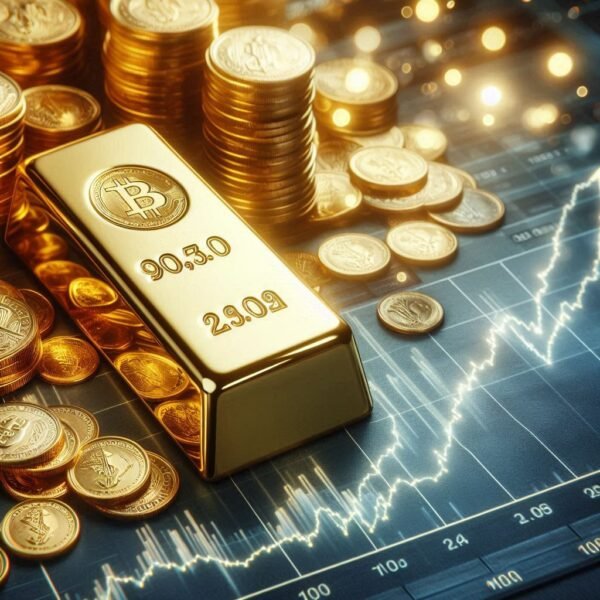Gold Price Vs. War

Gold prices historically rise during wars due to their status as a safe-haven asset, though the extent depends on the conflict’s duration, severity, and economic consequences.
Investor Sentiment: Gold’s intrinsic value and historical stability make it a refuge during geopolitical crises. Conflicts trigger a “flight to quality,” diverting investments from volatile stocks/bonds to gold.
Example: The 2022 Ukraine invasion and 2023 Israel-Hamas war drove gold to $2,000+/ounce, with all-time highs in 2024.
Mechanism: Preemptive buying often occurs even before hostilities begin.
Inflationary Pressures: Wars increase government spending (e.g., military budgets), often financed by money printing, which devalues currencies and boosts gold’s appeal as an inflation hedge.
Case Study: The Iraq War (2003–2011) correlated with gold’s bull market, peaking near $1,900/ounce by 2011.
Recession Fears: Prolonged conflicts risk economic downturns, further incentivizing gold investments. Even speculative fears of recession can drive prices up.
Historical Examples
| Conflict | Gold Price Impact |
|---|---|
| World War II (1939–1945) | Price more than doubled, though fixed at $35/ounce initially under the gold standard. |
| Vietnam War (1955–1975) | Rose >50% amid stagflation and currency crises. |
| Gulf War (1990–1991) | Increased >20% due to oil price shocks and Middle East instability. |
| Russia-Ukraine War (2022) | Surged to $2,000+/ounce within weeks of the invasion. |
Short vs. Prolonged Conflicts: Brief wars (e.g., Falklands War) may cause minor price shifts, while extended conflicts (e.g., Iraq War) lead to sustained rallies.
Global Economic Context: Gold’s performance also hinges on concurrent factors like interest rates and currency strength. For instance, the 2025 gold price surge to $3,000/ounce reflects both trade tensions and war-related uncertainty.
Gold’s wartime performance is less about conflict itself and more about its economic ripple effects—inflation, recession risks, and currency devaluation.
The relationship between gold prices and war is a classic example of how global uncertainty influences markets.
Why Gold Prices Often Rise During War:
Safe Haven Asset:
In times of geopolitical tension or war, investors often flock to gold because it’s perceived as a stable store of value. Unlike currencies or stocks, gold doesn’t rely on a country’s economic performance.
Currency Devaluation and Inflation:
Wars can lead to inflation (from increased government spending) or devaluation of a country’s currency. Gold, being denominated in USD globally, often gains value as a hedge.
Supply Chain & Mining Disruptions:
If a conflict affects regions that produce gold or the logistics to transport it, supply concerns can also push prices higher.
Exceptions – When Gold Might Not Surge:
If markets believe the war is short-lived or localized, there might not be a sustained impact on gold.
If interest rates are rising aggressively, investors might prefer interest-bearing assets over non-yielding gold.
Historical Examples:
| Conflict/Event | Gold Price Trend |
|---|---|
| Vietnam War (1965–1975) | Long-term rise; US left the gold standard. |
| Gulf War (1990–1991) | Short spike; fell quickly post-conflict. |
| 9/11 & Iraq War (2001–2003) | Steady rise as tensions remained high. |
| Russia-Ukraine War (2022) | Sharp spike initially; volatility followed. |
Gold has historically been considered a safe-haven asset, meaning investors tend to flock to it during times of uncertainty and crisis in the global economy. Wars and geopolitical tensions are significant events that create such uncertainty, and therefore, they often have a notable impact on the price of gold.
Why Gold Prices Tend to Rise During Wars:
Safe Haven Demand: During wars, there is often increased fear and uncertainty about the stability of economies, currencies, and other investments like stocks. Gold is perceived as a store of value that can hold its worth regardless of political or economic turmoil. This increased demand drives its price up.
Economic Instability: Wars can disrupt economic activity, trade, and supply chains, leading to inflation or even recession. Gold is seen as a hedge against inflation and a safe asset during economic downturns.
Currency Devaluation: Governments involved in wars may print more money to finance military expenditures, leading to the devaluation of their currencies. Investors may turn to gold as a way to preserve their wealth against currency depreciation.
Geopolitical Risk: The escalation of geopolitical tensions and the outbreak of war increase the perceived risk in financial markets. Investors tend to reduce their exposure to riskier assets and move towards safer options like gold.
Historical Examples:
World Wars: Both World War I and World War II saw significant increases in gold prices as investors sought refuge from the uncertainties of the global conflicts.
Soviet Invasion of Afghanistan (1979) and Russia’s Invasion of Ukraine (2022): These events were followed by substantial increases in the average spot price of gold.
Iraq War (2003-2011): This prolonged conflict led to a notable bull market for gold.
Israel-Palestine Conflicts: Escalations in tensions and outbreaks of conflict have often resulted in a rise in gold prices.
Gold doesn’t always move in direct lockstep with every minor conflict, major wars and periods of significant geopolitical instability generally create an environment where the demand for safe-haven assets like gold increases, leading to a rise in its price.
Gold prices often rise during wars due to its status as a safe-haven asset. Geopolitical uncertainty drives investors to gold, increasing demand and prices. Historically, major conflicts like World War II, the Vietnam War, and the Iraq War saw gold prices surge, often by 20-50% or more, due to heightened demand, currency devaluation, and inflation fears. For example, during the Russia-Ukraine conflict starting in 2022, gold prices spiked significantly, and the Israel-Hamas war in 2023 pushed prices up by about 1-2%.
Short-term conflicts (e.g., regional wars like Iran-Iraq) cause smaller, temporary price fluctuations.
Major wars between global powers or prolonged conflicts (e.g., Russia-Ukraine) lead to sustained increases due to economic disruptions, inflation, and supply chain issues. Russia, a top gold producer, faced sanctions during the Ukraine war, tightening global supply and boosting prices.
Economic fallout, like inflation or currency weakening, often has a stronger effect than the war itself. For instance, the 1973 Yom Kippur War’s oil price spike drove gold from $90.50/oz to $195/oz by late 1974 due to inflation, not just the conflict.
Recent data shows gold hitting record highs above $3,400/oz in April 2025, partly due to U.S.-China trade tensions, which mimic war-like economic uncertainty.
Wars typically push gold prices up, but the extent depends on the conflict’s scale, duration, and economic ripple effects. Always cross-check with real-time market data, as prices are volatile.
